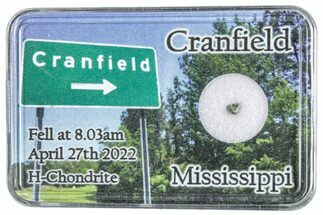.04" Portales Valley Chondrite Meteorite Slice - New Mexico
This is a .04" wide fragment of the H6 chondrite meteorite known as Portales Valley, which fell on June 13, 1998 in New Mexico to numerous eyewitnesses. It comes in a bespoke acrylic display case.
Portales Valley is an H6 chondrite named for the town it fell near in New Mexico on June 13, 1998. Over 70 kilograms of space rock landed within a strewn field that included a barn: chunks of meteorite punched through its roof and embedded themselves in a wall! Before it made its smashing entrance, eyewitnesses reported seeing smoky trails in the sky and hearing explosions as the Portales meteorite approached the ground.
Portales Valley is metal-rich for a chondrite: some recovered specimens are composed largely of metal. Numerous metal-rich shock veins can be found throughout, and larger patches of metal reveal Widmanstätten patterns upon etching. The metal grafts together a chondritic breccia in unusually angular shapes. It resembles stony-iron mesosiderites or achondritic winonaites, but its composition is overall closest to that of other H5 chondrites.
Portales Valley is metal-rich for a chondrite: some recovered specimens are composed largely of metal. Numerous metal-rich shock veins can be found throughout, and larger patches of metal reveal Widmanstätten patterns upon etching. The metal grafts together a chondritic breccia in unusually angular shapes. It resembles stony-iron mesosiderites or achondritic winonaites, but its composition is overall closest to that of other H5 chondrites.
About Chondrites
Chondrites are stony (non-metallic) meteorites that have not been modified by either melting or differentiation of the parent body. They are formed when various types of dust and small grains in the early Solar System accreted to form primitive asteroids. Some such bodies are captured in the planet’s gravity well and pulled to the surface. They are by far the most common type of meteorite, representing about 86 percent of all meteorites that have fallen to Earth.
Prominent among the components present in chondrites are the enigmatic chondrules, millimeter-sized spherical objects that originated as freely floating, molten or partially molten droplets in space; most chondrules are rich in the silicate minerals olivine and pyroxene. Chondrites also contain particles of various metals such as nickel, iron, and aluminum. These formed at the very beginning of the solar system and aggregated over time: they are the oldest rocks known on Earth!
Chondrites are divided into about fifteen distinct groups on the basis of their mineralogy, bulk chemical composition, and oxygen isotope compositions. The various chondrite groups likely originated on separate asteroids or groups of related asteroids. Each chondrite group has a distinctive mixture of chondrules, refractory inclusions, matrix (dust), characteristic chondrule sizes, and other components. Other ways of classifying chondrites include weathering and shock. The L chondrite group is the most common of these.
Chondrites are stony (non-metallic) meteorites that have not been modified by either melting or differentiation of the parent body. They are formed when various types of dust and small grains in the early Solar System accreted to form primitive asteroids. Some such bodies are captured in the planet’s gravity well and pulled to the surface. They are by far the most common type of meteorite, representing about 86 percent of all meteorites that have fallen to Earth.
Prominent among the components present in chondrites are the enigmatic chondrules, millimeter-sized spherical objects that originated as freely floating, molten or partially molten droplets in space; most chondrules are rich in the silicate minerals olivine and pyroxene. Chondrites also contain particles of various metals such as nickel, iron, and aluminum. These formed at the very beginning of the solar system and aggregated over time: they are the oldest rocks known on Earth!
Chondrites are divided into about fifteen distinct groups on the basis of their mineralogy, bulk chemical composition, and oxygen isotope compositions. The various chondrite groups likely originated on separate asteroids or groups of related asteroids. Each chondrite group has a distinctive mixture of chondrules, refractory inclusions, matrix (dust), characteristic chondrule sizes, and other components. Other ways of classifying chondrites include weathering and shock. The L chondrite group is the most common of these.
$25
TYPE
Ordinary Chondrite (H6)
LOCATION
Near Portales, Roosevelt County, New Mexico
SIZE
.04" wide
CATEGORY
ITEM
#286031
 Reviews
Reviews









